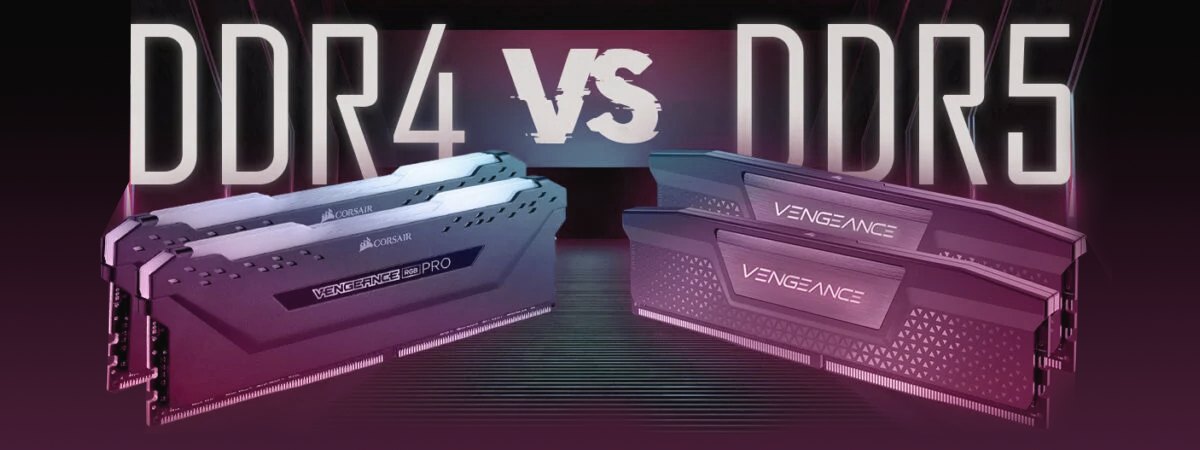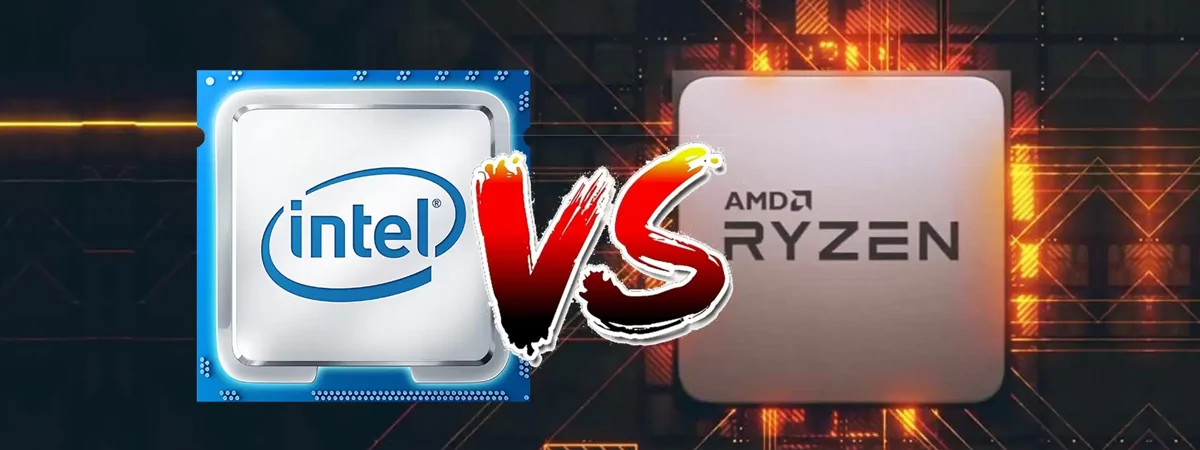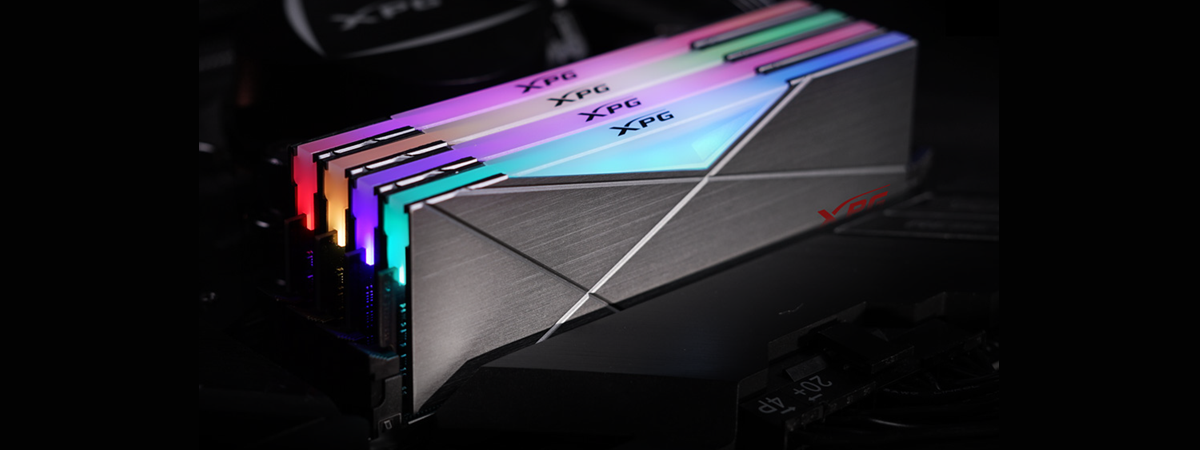
The Core i9-13900K is one of the most powerful desktop processors created so far by Intel. Part of the Raptor Lake family, it’s built on a hybrid architecture similar to the one used on Alder Lake but with improved performance and significantly higher frequencies. What makes these CPUs, and especially the Intel Core i9-13900K, so special? What’s the underlying technology that makes them tick the way they do? Furthermore, is it worth attempting to overclock such a powerful processor? Read on and find out more:
Why is the Intel Core i9-13900K a remarkable processor?
There are several reasons why the Intel Core i9-13900K is one of the best CPUs in 2023:
- For one, there’s the raw performance you get from it (you can read more about that in my Intel Core i9-13900K review), which is more than any other desktop CPU on the market right now can offer, with the sole exception of the newly launched Intel Core i9-13900KS.
- Second, there’s the price issue, where the Intel Core i9-13900K proves to be a more affordable option than its competitor (AMD Ryzen 9 7950X) when you put together all the costs involved in building a brand new desktop computer (such as the cost of the motherboard and memory).
- And third, there are the overclocking capabilities. While the Core i9-13900K can already run by default at a very high frequency of up to 5.8 GHz in boost mode, it’s practically unlocked in all aspects: there’s no limit to the voltage or power consumption, meaning that as long as you can cool it, this processor can run at almost any speed. Sure, that’s a challenging thing to do, but still, the possibility exists.
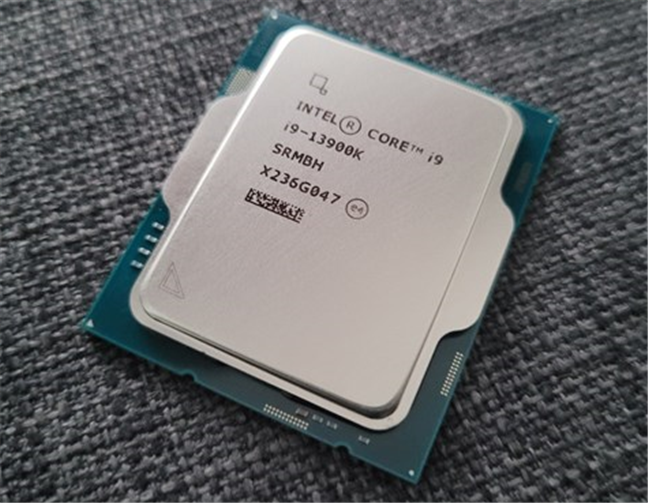
The Intel Core i9-13900K desktop CPU
The question is: how did Intel manage to create such a processor? Here’s what you should know:
What are Intel Raptor Lake processors, and how do they work?
To understand why the Intel Core i9-13900K is such a great processor, we must be cognizant of the underlying technology of the Intel Raptor Lake CPUs. As you probably already know, the latest two generations of Intel CPUs - Gen 12 Alder Lake and Gen 13 Raptor Lake - are fabricated on completely different architectures than their forefathers.
Any Alder Lake or Raptor Lake processor you look at is not just a processor in the traditional meaning of the word; it’s also an SoC (System on Chip). Unlike older CPUs, these new types of processors use a hybrid architecture that includes two distinct types of cores: performance and efficiency cores.
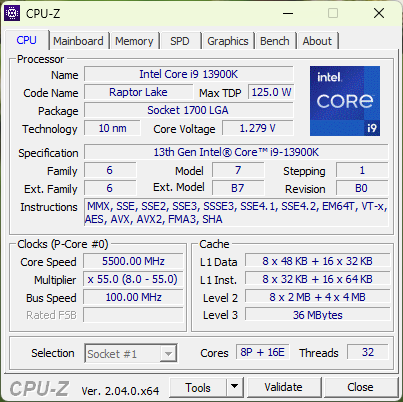
Intel Core i9-13900K specifications
The performance cores, also known as P-cores, are designed to deliver maximum performance in the most demanding tasks, while efficiency cores are in charge of running background activities. In other words, P-cores should fire up when you’re playing a game, for instance, as such an activity requires a lot of processor resources. At the same time, apps and services that are not in the foreground should be automatically assigned to the efficiency cores in order to relieve the P-cores.
What is Intel Thread Director?
All that sounds great, but things are not as simple as they seem. It’s not enough for such a processor to have different cores on it: it needs something else to handle the running tasks and allocate them to the appropriate cores. That something else is the Intel Thread Director, a built-in artificial intelligence that relies on machine learning algorithms to automatically identify which apps, processes, and services require more performance at any given moment and which don’t.
Intel Thread Director is a technology integrated directly into the hardware of 12th and 13th Generation Intel Core processors. This hardware scheduler works best with Windows 11, as this is the only operating system capable of taking advantage of the different cores and sending the right app (thread) to the right core(s).
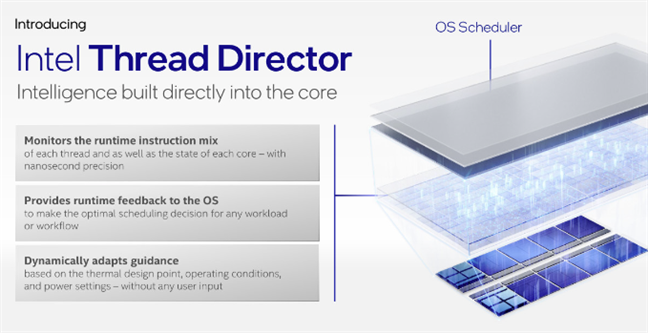
Intel Thread Director
Although the Intel Thread Director is a feature that improves the multitasking performance of all Intel Core processors from the 12th and 13th generations, this hardware-based scheduler is not the same on Alder Lake and Raptor Lake. While Intel developed and launched the Thread Director together with Alder Lake CPUs, the company didn’t become complacent after that, and with the latest Raptor Lake processors, we got a new and updated version of the scheduler: Intel Thread Director 2. There aren’t many details on the internet on exactly what’s changed in version 2 compared to version 1, but as far as tests and benchmarks show, the performance improvements brought by the Raptor Lake CPUs are quite visible.
What about overclocking the Intel Core i9-13900K?
The Intel Core i9-13900K is already a powerful processor, but you can improve its performance even more by overclocking it. You’ve probably heard that ASUS’ overclocking team managed to overclock it to 9 GHz (!), breaking all the previous world records. Though we can’t hope for anything like that at home using regular cooling solutions and power supplies, we can however attempt to get a couple hundred more megahertz from this CPU. Even so, the performance improvements will be visible and, I’d say, noteworthy. If you’re curious, I’ll show you the results of my attempt at overclocking the Intel Core i9-13900K.
As you know, this processor has 24 cores and 32 threads. There are 8 performance cores on it that run at a base clock of 3 GHz and can reach a maximum turbo frequency of 5.80 GHz, and 16 efficient cores that run at a base clock of 2.2 GHz and a maximum turbo frequency of 4.3 GHz. The CPU also features 36 MB of Intel Smart Cache, out of which 32 MB are Level 2. The advertised processor base power is 125 Watts, while the maximum turbo power is 253 Watts.
After a lot of trial and error testing, I managed to increase the frequencies of the Intel Core i9-13900K as follows:
- 2 P-cores running at up to 6 GHz
- 6 P-cores running at up to 5.6 GHz
- All 16 E-cores running at up to 4.4 GHz
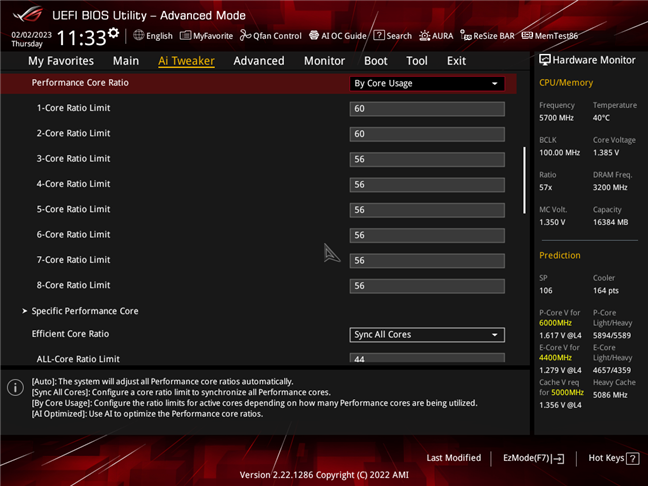
Overclocking settings for the Intel Core i9-13900K
Furthermore, thanks to another tech from Intel, Thermal Velocity Boost (TVB), which allows the CPU to increase one or two of its cores’ clocks even more when thermal headroom and turbo power budget are available, the Intel Core i9-13900K was theoretically able to reach up to 6.2 GHz maximum frequency.
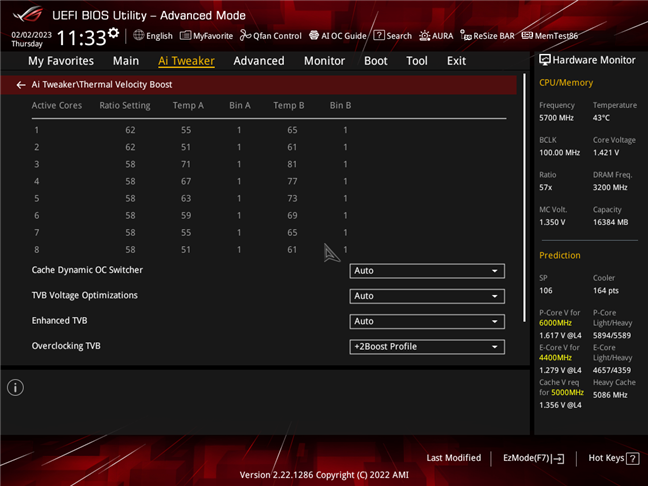
Thermal Velocity Boost enabled for the Intel Core i9-13900K
Before showing you the results of the overclocked processor in benchmarks, here are the hardware and software I used:
- Motherboard: ASUS ROG Strix Z790-A Gaming WiFi D4
- RAM: HyperX Predator DDR4 RGB 16GB 3200MHz CL16
- Graphics Card: AMD Radeon RX 7900 XT
- Storage: Kingston KC3000 PCIe 4.0 NVMe M.2 2TB SSD
- Power Supply Unit: ASUS ROG Thor 850 W Platinum
- Operating System: Windows 11 Pro Version 22H2
I started the benchmarks for the Intel Core i9-13900K with the CPU-Z single-thread test. It got a score of 931 points, which represents a 4.25% increase in performance compared to when not overclocked.
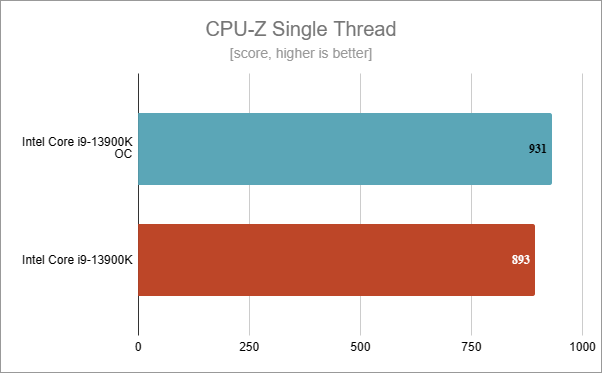
Benchmark results in CPU-Z Single Thread
In CPU-Z’s multi-thread benchmark, overclocking the Intel Core i9-13900K resulted in a smaller but noticeable performance increase of 1.44%.
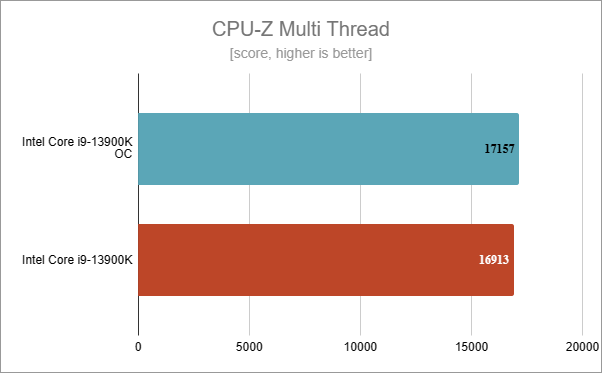
Benchmark results in CPU-Z Multi Thread
In the Cinebench R23 rendering benchmark, the overclocked Intel Core i9-13900K delivered a major improvement in performance: 9.08%!
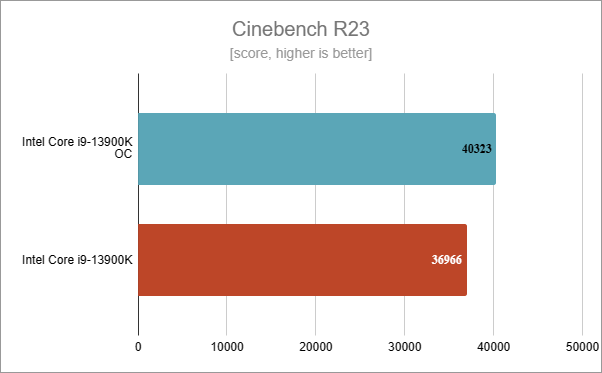
Benchmark results in Cinebench R23
In Blender, also a rendering benchmark, the overclocked Intel Core i9-13900K was again faster than its non-OC version, although the improvement was not as remarkable as in Cinebench R23: 3.23%.
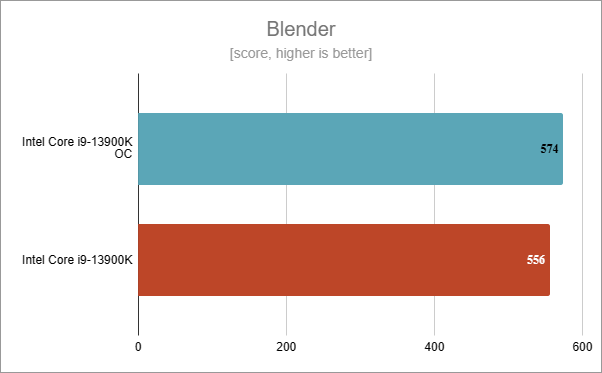
Benchmark results in Blender
I also tested web browsing performance using JetStream 2 in Google Chrome. Here, overclocking the Intel Core i9-13900K delivered a performance increase of 4.36% compared to running at default frequencies.
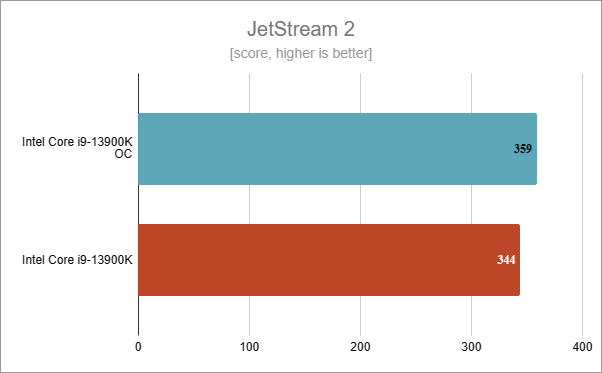
Benchmark results in JetStream 2
The last benchmark I ran was 3DMark’s CPU Profile. The overclocked Intel Core i9-13900K scored 17203 points, which compared to the 16447 points of its non-overclocked version, translates into a performance improvement of 4.59%.
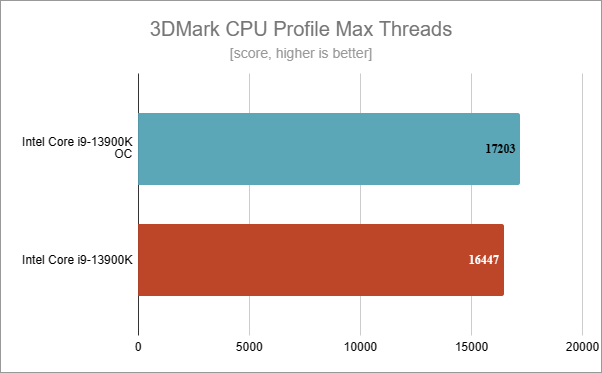
Benchmark results in 3DMark CPU Profile Max Threads
Obviously, during all the benchmarks, I’ve kept an eye on the temperatures. The maximum I’ve seen was 98 degrees Celsius (~208.4 degrees Fahrenheit) under multi-thread load, using the overclock settings I mentioned earlier. With a beefier cooling solution and a more powerful power supply unit, you might get even better results. In my case, any further increase in frequency was not possible as this looked like the top limit before the computer would simply shut down.
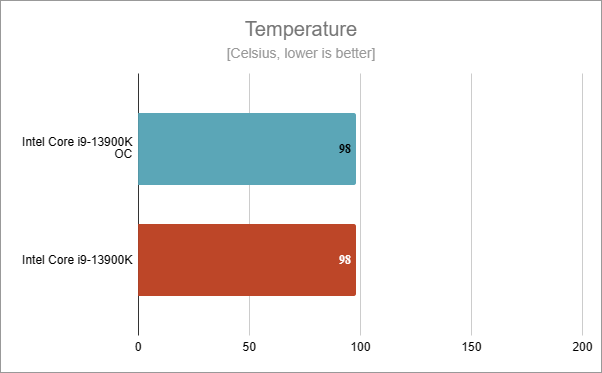
Intel Core i9-13900K OC temperature
As the overclock I did wasn’t an all-core one, nor did I increase the frequencies too much, the maximum amount of power that the overclocked Intel Core i9-13900K required wasn’t significantly higher than the maximum “factory” value I measured for the CPU when not overclocked: 267 Watts compared to 253 Watts.
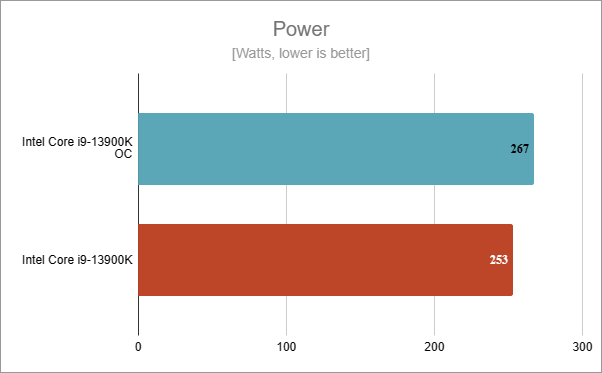
Intel Core i9-13900K OC power consumption
To conclude, yes, I believe it’s worth overclocking the Intel Core i9-13900K. The additional performance you can get from it is noteworthy, even with a modest overclock. However, you’ll probably be able to do that only if you have a high-end motherboard able to keep it stable, a beefy power supply unit (850 Watts minimum, 1000 Watts recommended), and a good-quality AIO cooling solution (with a radiator that’s at least 240 mm; I recommend a 360 mm model).
NOTE: In making this material, we collaborated with ASBIS Romania. They sent us the processor used for our overclocking experiments. ASBIS Romania is an international distributor of Intel processors in general, and of Intel Core i9-13900K in particular.
What’s your take on the Intel Core i9-13900K processor?
Now you know more about why the Intel Core i9-13900K is one of the best CPUs in town. Going from the refined architecture used by the Raptor Lake processors to the Intel Thread Director technology and the potential you can unleash by overclocking it, the Core i9-13900K is, simply put, an amazing processor. What do you think? Let me know in the comments below.




